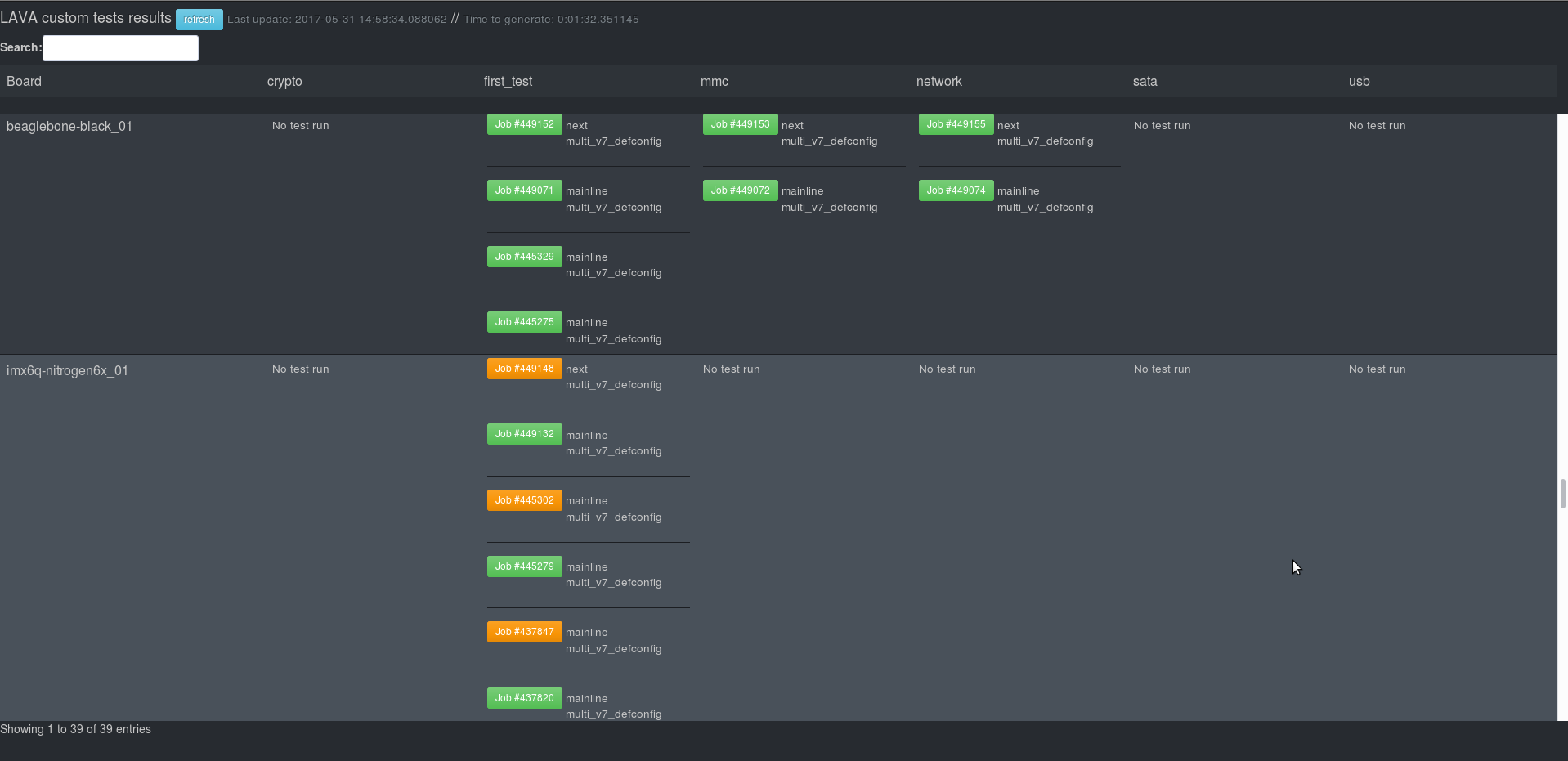As part of a partnership with the eBPF Foundation, Bootlin engineers Bastien Curutchet and Alexis Lothoré are working with the kernel community in order to improve eBPF support in the kernel on different aspects. This post is the first one of a series highlighting this effort. For those who need to catch up with the eBPF technology, you can take a look at our “Linux Debugging, tracing and profiling” training course which has been recently updated with eBPF basics !
partnership with the eBPF Foundation, Bootlin engineers Bastien Curutchet and Alexis Lothoré are working with the kernel community in order to improve eBPF support in the kernel on different aspects. This post is the first one of a series highlighting this effort. For those who need to catch up with the eBPF technology, you can take a look at our “Linux Debugging, tracing and profiling” training course which has been recently updated with eBPF basics !
Tag: testing
LTP: Linux Test Project, Bootlin contributions
Introduction
The Linux Test Project is a project that develops and maintains a large test suite that helps validating the reliability, robustness and stability of the Linux kernel and related features. LTP has been mainly developed by companies such as IBM, Cisco, Fujitsu, SUSE, RedHat, with a focus on desktop distributions.
On the embedded side, both the openembedded-core Yocto layer and Buildroot have packages that allow to use LTP on embedded targets. However, for a recent project, we practically tried to run the full LTP test suite on an i.MX8 based platform running a Linux system built with Yocto. It turned out that LTP was apparently not very often tested on Busybox-based embedded systems, and we faced a number of issues. In addition to reporting various bugs/issues to the upstream LTP project, we also contributed a number of fixes and improvements:
- testcases: ar: Add TST_NEEDS_CMDS on “ar”
- testcases: file: Add TST_NEEDS_CMDS on readelf
- testcases: tar: Add TST_NEEDS_CMDS on gzip and bzip
- testcases: logrotate: Check if “file” command exists
- testcases: wc: Add “unrecognized option” as TCONF
- syscalls: ioctl03: Handle ENOENT error
- testcase: gethostid: Check if hostid is available
- testcase: lib: Create tst_getconf to replace “getconf”
- testcases: Replace “getconf” by “tst_getconf”
- tcp_cmds/ping/ping02: Make it compatible with Busybox
- network/traceroute01: make it compatible with Busybox
- net/host: update to new API
- net/ip_tests: Return TCONF if driver dummy not present
- net: netstat: clean and update to the new API
- fastopen: add require to sch_netem driver
- ipsec_lib: make tst_net_run “tst_check_driver” quiet
- containers/netns: update netns shell test to new API
- sctp/func_test: add check on the sctp driver
- quota_remount_test01: update to new API
- cmdlib: Update exists function to exit with TCONF
Our contributions received a very warm welcome in the LTP community, which turned out to be very open and responsive. We hope that these contributions will encourage others to use LTP, and hopefully to make sure it continues to work on embedded platforms.
Quick start guide
At the time of this writing, LTP has more than 3800 tests written by the community, including about 1000 network-related tests. The tests are grouped together in categories described by files in the runtest/ folder. Based on this, two scenarios of tests are defined: default and network which are described by two files in the scenario_groups/ folder. These two scenarios simply list the categories of tests that need to be executed.
Here are the contents of the default and network:
$ cat scenario_groups/default syscalls fs fs_perms_simple fsx dio io mm ipc sched math nptl pty containers fs_bind controllers filecaps cap_bounds fcntl-locktests connectors power_management_tests hugetlb commands hyperthreading can cpuhotplug net.ipv6_lib input cve crypto kernel_misc uevent
$ cat scenario_groups/network can net.features net.ipv6 net.ipv6_lib net.tcp_cmds net.multicast net.rpc net.nfs net.rpc_tests net.tirpc_tests net.sctp net_stress.appl net_stress.broken_ip net_stress.interface net_stress.ipsec_dccp net_stress.ipsec_icmp net_stress.ipsec_sctp net_stress.ipsec_tcp net_stress.ipsec_udp net_stress.multicast net_stress.route
Once you have LTP built and installed on your board thanks to the appropriate OpenEmbedded or Buildroot package, you can run these two scenarios of test with the following commands (-n specify the network one):
$ cd /opt/ltp $ ./runltp $ ./runltp -n
Then take a look at the content of the result and the output directories.
For more information on building or running LTP please read this readme.
Beyond boot testing: custom tests with LAVA
Since April 2016, we have our own automated testing infrastructure to validate the Linux kernel on a large number of hardware platforms. We use this infrastructure to contribute to the KernelCI project, which tests every day the Linux kernel. However, the tests being done by KernelCI are really basic: it’s mostly booting a basic Linux system and checking that it reaches a shell prompt.
However, LAVA, the software component at the core of this testing infrastructure, can do a lot more than just basic tests.
The need for custom tests
With some of our engineers being Linux maintainers and given all the platforms we need to maintain for our customers, being able to automatically test specific features beyond a simple boot test was a very interesting goal.
In addition, manually testing a kernel change on a large number of hardware platforms can be really tedious. Being able to quickly send test jobs that will use an image you built on your machine can be a great advantage when you have some new code in development that affects more than one board.
We identified two main use cases for custom tests:
- Automatic tests to detect regression, as does KernelCI, but with more advanced tests, including platform specific tests.
- Manual tests executed by engineers to validate that the changes they are developing do not break existing features, on all platforms.
Overall architecture
Several tools are needed to run custom tests:
- The LAVA instance, which controls the hardware platforms to be tested. See our previous blog posts on our testing hardware infrastructrure and software architecture
- An appropriate root filesystem, that contains the various userspace programs needed to execute the tests (benchmarking tools, validation tools, etc.)
- A test suite, which contains various scripts executing the tests
- A custom test tool that glues together the different components
The custom test tool knows all the hardware platforms available and which tests and kernel configurations apply to which hardware platforms. It identifies the appropriate kernel image, Device Tree, root filesystem image and test suite and submits a job to LAVA for execution. LAVA will download the necessary artifacts and run the job on the appropriate device.
Building custom rootfs
When it comes to test specific drivers, dedicated testing, validation or benchmarking tools are sometimes needed. For example, for storage device testing, bonnie++ can be used, while iperf is nice for networking testing. As the default root filesystem used by KernelCI is really minimalist, we need to build our owns, one for each architecture we want to test.
Buildroot is a simple yet efficient tool to generate root filesystems, it is also used by KernelCI to build their minimalist root filesystems. We chose to use it and made custom configuration files to match our needs.
We ended up with custom rootfs built for ARMv4, ARMv5, ARMv7, and ARMv8, that embed for now Bonnie++, iperf, ping (not the Busybox implementation) and other tiny tools that aren’t included in the default Buildroot configuration.
Our Buildroot fork that includes our custom configurations is available as the buildroot-ci Github project (branch ci).
The custom test tool
The custom test tool is the tool that binds the different elements of the overall architecture together.
One of the main features of the tool is to send jobs. Jobs are text files used by LAVA to know what to do with which device. As they are described in LAVA as YAML files (in the version 2 of the API), it is easy to use templates to generate them based on a single model. Some information is quite static such as the device tree name for a given board or the rootfs version to use, but other details change for every job such as the kernel to use or which test to run.
We made a tool able to get the latest kernel images from KernelCI to quickly send jobs without having a to compile a custom kernel image. If the need is to test a custom image that is built locally, the tool is also able to send files to the LAVA server through SSH, to provide a custom kernel image.
The entry point of the tool is ctt.py, which allows to create new jobs, providing a lot of options to define the various aspects of the job (kernel, Device Tree, root filesystem, test, etc.).
This tool is written in Python, and lives in the custom_tests_tool Github project.
The test suite
The test suite is a set of shell scripts that perform tests returning 0 or 1 depending on the result. This test suite is included inside the root filesystem by LAVA as part of a preparation step for each job.
We currently have a small set of tests:
- boot test, which simply returns 0. Such a test will be successful as soon as the boot succeeds.
- mmc test, to test MMC storage devices
- sata test, to test SATA storage devices
- crypto test, to do some minimal testing of cryptographic engines
- usb test, to test USB functionality using mass storage devices
- simple network test, that just validates network connectivity using ping
All those tests only require the target hardware platform itself. However, for more elaborate network tests, we needed to get two devices to interact with each other: the target hardware platform and a reference PC platform. For this, we use the LAVA MultiNode API. It allows to have a test that spans multiple devices, which we use to perform multiple iperf sessions to benchmark the bandwidth. This test has therefore one part running on the target device (network-board) and one part running on the reference PC platform (network-laptop).
Our current test suite is available as the test_suite Github project. It is obviously limited to just a few tests for now, we hope to extend the tests in the near future.
First use case: daily tests
As previously stated, it’s important for us to know about regressions introduced in the upstream kernel. Therefore, we have set up a simple daily cron job that:
- Sends custom jobs to all boards to validate the latest mainline Linux kernel and latest linux-nextli>
- Aggregates results from the past 24 hours and sends emails to subscribed addresses
- Updates a dashboard that displays results in a very simple page

Second use case: manual tests
The custom test tool ctt.py has a simple command line interface. It’s easy for someone to set it up and send custom jobs. For example:
ctt.py -b beaglebone-black -m network
will start the network test on the BeagleBone Black, using the latest mainline Linux kernel built by KernelCI. On the other hand:
ctt.py -b armada-7040-db armada-8040-db -t mmc --kernel arch/arm64/boot/Image --dtb-folder arch/arm64/boot/dts/
will run the mmc test on the Marvell Armada 7040 and Armada 8040 development boards, using the locally built kernel image and Device Tree.
The result of the job is sent over e-mail when the test has completed.
Conclusion
Thanks to this custom test tool, we now have an infrastructure that leverages our existing lab and LAVA instance to execute more advanced tests. Our goal is now to increase the coverage, by adding more tests, and run them on more devices. Of course, we welcome feedback and contributions!

